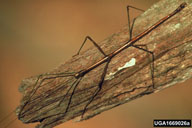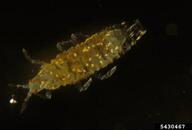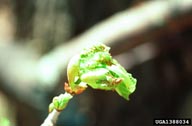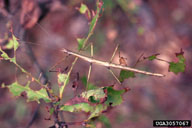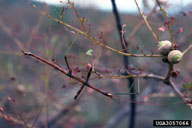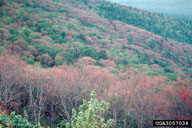Northern walkingstick
Diapheromera femorata (Say) (Phasmatodea: Heteronemiidae)
Orientation to pest
The northern walkingstick, Diapheromera femorata (Say), is the only walkingstick of economic importance in the USA. While young nymphs feed on shrubs of various species, older nymphs and adults feed on leaves of a wide variety of hardwood trees. Populations at times are dense enough to completely defoliate affected trees. Eggs fall from trees and when populations are dense, sounds of falling eggs are readily noticed. Overwintering occurs in the egg stage.
Hosts commonly attacked
Species fed on by the northern walkingstick include black (Quercus velutina Lamb.) and red (Quercus rubra L.) oaks, American basswood (Tilia americana L.), American elm (Ulnus americana L.), black locust (Robinia pseudoacacia L.), cherry (Prunus spp.), and other hardwoods.
Distribution
This walkingstick is found in southern Canada and most of the eastern United States, west to the Texas and the Great Plains.
Images of northern walkingstick
| Figure 1. Adult of the northern walkingstick, Diapheromera femorata | Figure 2. Mating pair of the northern walkingstick; small male mounted on large female | Figure 3. Seed-like eggs of the northern walkingstick being examined by an ant |
| Figure 4. Oak foliage showing feeding of the walkingstick | Figure 5. Forest in Mena, Arizona partially defoliated by the walkingstick | |
Important biological control agents related to this pest species
The parasitoid Mesitiopterus kahlii (Ashmead) (Hymenoptera: Chrysididae) attacks the D. femorata. Also, birds can feed heavily on walkingsticks when their population densities are high.
Web links for information on northern walkingstick
Articles
- Ignoffo, C. M., D. L. Hostetter, and W. H. Kearby. 1973. Susceptibility of walkingstick, orangestriped oakworm and variable oakleaf caterpillar, to Bacillus thuringiensis var. alesti. Environmental Entomology 2: 807-809.
- Giese, R. L. and K. H. Knauer. 1977. Ecology of the walkingstick. Forest Science 23: 45-63.
